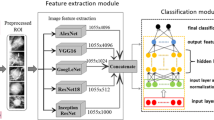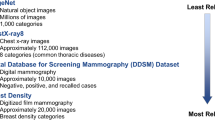Abstract
This research intends to provide a method for clinical decision support systems that can accurately classify benign and malignant mass from breast X-ray images. The model was initially trained and assessed using distinct convolutional neural network (CNN) models. Based on the comparative analysis, the best models were then selected and used for further implementation. The work employs an average, weighted average and concatenation strategy that seeks to merge pre-trained CNN, relying on the transfer learning technique to construct a highly accurate ensemble model. The models make it possible to save and use the information gained from a pre-trained CNN for a new task, namely breast mammogram classification. A benchmark datasets such as MIAS, CBIS-DDSM and a private dataset with two classes, benign and malignant, were used in the proposed approach. To assess the proposed model’s efficacy, several generic assessment techniques were employed. Our ensemble model outperforms other state-of-the-art methods with an overall accuracy (99.76%), Sensitivity (99.84%), Specificity(99.76%), Precision(99.76%) and F1-Score(99.76%).








Similar content being viewed by others
References
Sung H, Ferlay J, Siegel R, Laversanne M, Soerjomataram I, Jemal A, Bray F (2021)“Global cancer statistics 2020: Globocan estimates of incidence and mortality worldwide for 36 cancers in 185 countries.”CA: Cancer J Clinic 71(3): 209–249
Adachi Y, Ishiguro J, Kotani H, Hisada T, Ichikawa M, Gondo N, Yoshimura A, Kondo N, Hattori M, Sawaki M (2016) Comparison of clinical outcomes between luminal invasive ductal carcinoma and luminal invasive lobular carcinoma. BMC Cancer 16(1):1–9
Du T, Zhu L, Levine K, Tasdemir N, Lee A, Vignali D, Houten B, Tseng G, Oesterreich S (2018) Invasive lobular and ductal breast carcinoma differ in immune response, protein translation efficiency and metabolism. Sci Rep 8(1):1–11
Iranmakani S, Mortezazadeh T, Sajadian F, Ghaziani M, Ghafari A, Khezerloo D, Musa A (2020) A review of various modalities in breast imaging: technical aspects and clinical outcomes. Egyptian J Radiol Nucl Med 51(1):1–22
Islam S, Kaabouch N, Hu W (2013) “A survey of medical imaging techniques used for breast cancer detection,” In: IEEE International Conference on Electro Information Technology, EIT 2013 IEEE, pp 1–5
Welch G, Prorok P, O’Malley J, Kramer B (2016) Breast-cancer tumor size, overdiagnosis, and mammography screening effectiveness. N Engl J Med 375(15):1438–1447
Oza P, Sharma P, Patel S, Bruno A (2021) A bottom-up review of image analysis methods for suspicious region detection in mammograms. J Imaging 7:190. https://doi.org/10.3390/jimaging7090190
Saber A, Sakr M, Abo-Seida O, Keshk A, Chen H (2021) “A novel deep-learning model for automatic detection and classification of breast cancer using the transfer-learning technique.” IEEE Access, vol 9: 71 194–71 209
Terrada O, Hamida S, Cherradi B, Raihani A, Bouattane O (2020) Supervised machine learning based medical diagnosis support system for prediction of patients with heart disease. Adv Sci Technol Eng Syst J 5(5):269–277
Xie J, Jiang J, Wang Y, Guan Y, Guo X (2020) Learning an expandable emr-based medical knowledge network to enhance clinical diagnosis. Artif Intell Med 107:101927
Terrada O, Cherradi B, Raihani A, Bouattane O (2020) A novel medical diagnosis support system for predicting patients with atherosclerosis diseases. Inform Med Unlock 21:100483
Alsaeedi A, Al-Sarem M (2020) Detecting rumors on social media based on a cnn deep learning technique. Arab J Sci Eng 45(12):10813–844
Vijh M, Chandola D, Tikkiwal V, Kumar A (2020) Stock closing price prediction using machine learning techniques. Procedia Comput Sci 167:599–606
Hassan N, Hamad S, Mahar K (2022)“Mammogram breast cancer cad systems for mass detection and classification: a review.” Multimedia Tools Appl, pp 1–33
Oza P, Sharma P, Patel S, Kumar P (2022) Deep convolutional neural networks for computer-aided breast cancer diagnostic: a survey. Neural Comput Appl 34:1815–1836
Oza P, Sharma P, Patel S, Kumar P (2022) Computer-aided breast cancer diagnosis: comparative analysis of breast imaging modalities and mammogram repositories. Curr Med Imaging 18:1–13
Oza P, Sharma P, Patel S, Adedoyin F, Bruno A (2022)“Image augmentation techniques for mammogram analysis.” J Imaging 8(5) Available: https://www.mdpi.com/2313-433X/8/5/141
Ali N, Ahmed E, Cherradi B (2022) The performances of iterative type-2 fuzzy c-mean on gpu for image segmentation. J Super comput 78(2):1583–1601
Oza P, Sharma P, Patel S (2022)“A drive through computer-aided diagnosis of breast cancer: a comprehensive study of clinical and technical aspects.” Recent Innov Comput pp 233–249
Oza P, Shah Y, Vegda M (2022)“A comprehensive study of mammogram classification techniques.” In: Tracking and preventing diseases with artificial intelligence. Springer, pp 217–238
Liu L, Shen C, Hengel A (2016) Cross-convolutional-layer pooling for image recognition. IEEE Trans Pattern Anal Mach Intell 39(11):2305–2313
Yamashita R, Nishio M, Do R, Togashi K (2018) Convolutional neural networks: an overview and application in radiology. Insights Imaging 9(4):611–629
Ha R., Jairam MP (2022) A review of artificial intelligence in mammography. Clinic Imaging 88:36–44. https://doi.org/10.1016/j.clinimag.2022.05.005
Simonyan K, Zisserman A (2014) “Very deep convolutional networks for large-scale image recognition.” arXiv preprint arXiv:1409.1556
He K, Zhang X, Ren S, Sun J (2016) “Deep residual learning for image recognition,” In: Proceedings of the IEEE Conference on Computer Vision and Pattern Recognition pp 770–778
Szegedy C, Vanhoucke V, Ioffe S, Shlens J, Wojna Z (2016) “Rethinking the inception architecture for computer vision.” In: Proceedings of the IEEE Conference on Computer Vision and Pattern Recognition pp 2818–2826
Tan M, Le Q (2019) “Efficientnet: Rethinking model scaling for convolutional neural networks.” In: International Conference on Machine Learning. PMLR, pp 6105–6114
Ganaie M, Hu M, Malik A, Tanveer M, Suganthan P (2022) Ensemble deep learning: a review. Eng Appl Artif Intell 115:105151
Suckling J, Parker J, Dance D, Astley S, Hutt I, Boggis C, Ricketts I, Stamatakis E, Cerneaz N, Kok S (2015) Mammographic image analysis society (mias) database v1 21 [Dataset]. https://www.repository.cam.ac.uk/handle/1810/250394
Sawyer R, Gimenez F, Hoogi A, Rubin D (2016) “Curated breast imaging subset of ddsm.” Cancer Imaging Archiv DOI: https://doi. org/10.7937 K, vol 9
Rehman M, Chong K (2020) Dna6ma-mint: Dna-6ma modification identification neural tool. Genes 11(8):898
Khan S, Islam N, Jan Z, Din IU, Rodrigues J (2019) A novel deep learning based framework for the detection and classification of breast cancer using transfer learning. Pattern Recogn Lett 125:1–6
Salama W, Aly M (2021) Deep learning in mammography images segmentation and classification: automated cnn approach. Alex Eng J 60(5):4701–4709
Adedigba A, Adeshina S, Aibinu A (2022) Performance evaluation of deep learning models on mammogram classification using small dataset. Bioengineering 9(4):161
Zhang X, Zhang Y, Han E, Jacobs N, Han Q, Wang X, Liu J (2018) Classification of whole mammogram and tomosynthesis images using deep convolutional neural networks. IEEE Trans Nanobiosci 17(3):237–242
Tsochatzidis L, Costaridou L, Pratikakis I (2019) Deep learning for breast cancer diagnosis from mammograms-a comparative study. J Imaging 5(3):37
Wang Y, Feng Y, Zhang L, Wang Z, Lv Q, Yi Z (2021) Deep adversarial domain adaptation for breast cancer screening from mammograms. Med Image Anal 73:102147
Haq I, Ali H, Wang H, Lei C, Ali H (2022) “Feature fusion and ensemble learning-based cnn model for mammographic image classification.” J King Saud Univ-Comput Inform Sci
Nguyen L, Gao R, Lin D, Lin Z (2019) “Biomedical image classification based on a feature concatenation and ensemble of deep cnns.” J Ambient Intell Human Comput pp 1–13
Altaf M (2021) A hybrid deep learning model for breast cancer diagnosis based on transfer learning and pulse-coupled neural networks. Math Biosci Eng 18(5):5029–5046
Hekal AA, Moustafa HED, Elnakib A (2022) Ensemble deep learning system for early breast cancer detection. Evol Intel. https://doi.org/10.1007/s12065-022-00719-w
Heath M, Bowyer K, Kopans D, Kegelmeyer P, Moore R, Chang K, Munishkumaran S (1998)“Current status of the digital database for screening mammography.” In: Digital mammography. Springer, pp 457–460
Krizhevsky A, Sutskever I, Hinton G (2012) Imagenet classification with deep convolutional neural networks. Adv Neural Inform Process Syst 25:1
Assiri A, Nazir S, Velastin S (2020) Breast tumor classification using an ensemble machine learning method. J Imaging 6(6):39
Alruwaili M, Gouda W (2022) Automated breast cancer detection models based on transfer learning. Sensors 22(3):876
Baccouche A, Garcia-Zapirain B, Elmaghraby A (2022) An integrated framework for breast mass classification and diagnosis using stacked ensemble of residual neural networks. Sci Reports 12(1):12259
Acknowledgements
The authors are thankful to the Samved Hospital, Ahmedabad, India, for providing anonymous mammogram images to carry out this research work. The authors are also grateful to the Department of Computer Science and Engineering, Nirma University, Ahmedabad, for providing computational resources for the investigations.
Funding
Not applicable.
Author information
Authors and Affiliations
Contributions
P.O helped in conceptualization; formal analysis; investigation; experiments; writing—original draft preparation; P.O. and P.S and S.P. contributed to writing—review and editing; P.S. and S.P supervised the study.
Corresponding author
Ethics declarations
Ethical Approval
Not applicable.
Competing interests
None to declare.
Availability of data and materials
Not applicable.
Additional information
Publisher's Note
Springer Nature remains neutral with regard to jurisdictional claims in published maps and institutional affiliations.
Rights and permissions
Springer Nature or its licensor (e.g. a society or other partner) holds exclusive rights to this article under a publishing agreement with the author(s) or other rightsholder(s); author self-archiving of the accepted manuscript version of this article is solely governed by the terms of such publishing agreement and applicable law.
About this article
Cite this article
Oza, P., Sharma, P. & Patel, S. Deep ensemble transfer learning-based framework for mammographic image classification. J Supercomput 79, 8048–8069 (2023). https://doi.org/10.1007/s11227-022-04992-5
Accepted:
Published:
Issue Date:
DOI: https://doi.org/10.1007/s11227-022-04992-5




